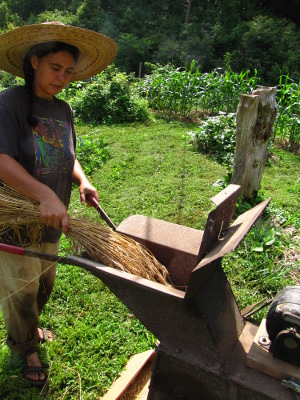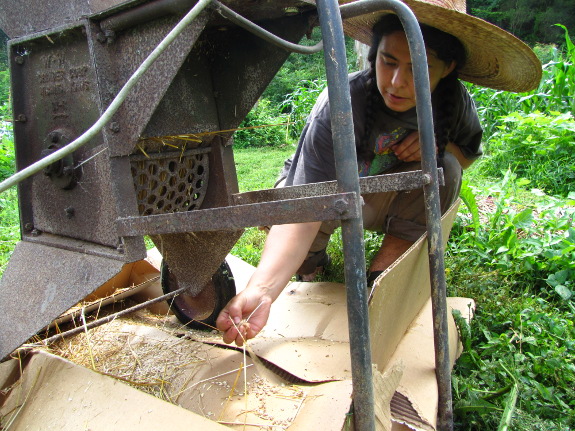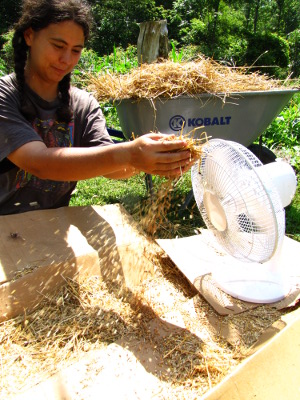
Threshing and winnowing wheat
 I originally meant to save
our first experimental wheat harvest for winter bedding/treats for the
chickens, but a pair of cardinals found the plants as they hung drying
under the eaves. I quickly changed my plans --- thresh
and winnow out the
grain so it doesn't all go in wild bird bellies.
I originally meant to save
our first experimental wheat harvest for winter bedding/treats for the
chickens, but a pair of cardinals found the plants as they hung drying
under the eaves. I quickly changed my plans --- thresh
and winnow out the
grain so it doesn't all go in wild bird bellies.
Mark's electric-converted
chipper/shredder was
a perfect threshing machine for the grain, with an old cardboard box
slipped underneath to catch the wheat. I learned that feeding
smaller hanks into the shredder works best, and that it is essential to
have all of the grain heads lined up. I'm glad I tried out the
threshing just for these pieces of wisdom since I'll save a lot of time
with future threshing by tweaking my harvesting technique.

 Plenty of chaff ended up in
the cardboard box with the wheat, so my next step was winnowing.
I raked the biggest pieces of stems together, tossing handfuls lightly
into the air so that heavy grains fell out the bottom to remain in the
box. Then I tossed handfuls of what remained higher, this time in
front of the fan, which worked quite well to remove most of the small
pieces of chaff from the seeds.
Plenty of chaff ended up in
the cardboard box with the wheat, so my next step was winnowing.
I raked the biggest pieces of stems together, tossing handfuls lightly
into the air so that heavy grains fell out the bottom to remain in the
box. Then I tossed handfuls of what remained higher, this time in
front of the fan, which worked quite well to remove most of the small
pieces of chaff from the seeds.
Total harvest was just
shy of three cups --- a terribly poor showing since I think I planted
about that much in the paddock last fall. However, I figure I
only got about 70% of the grain out with my quick and dirty threshing
(giving the rest to the chickens with their bedding
straw), and the
cardinals ate perhaps another 30% of the whole. And I had a lot
of problems
growing the wheat,
which is the main cause of the small harvest. I figure that for
our first real foray into growing grain, breaking even isn't too bad.
Want more in-depth information? Browse through our books.
Or explore more posts by date or by subject.
About us: Anna Hess and Mark Hamilton spent over a decade living self-sufficiently in the mountains of Virginia before moving north to start over from scratch in the foothills of Ohio. They've experimented with permaculture, no-till gardening, trailersteading, home-based microbusinesses and much more, writing about their adventures in both blogs and books.
Want to be notified when new comments are posted on this page? Click on the RSS button after you add a comment to subscribe to the comment feed, or simply check the box beside "email replies to me" while writing your comment.

That's interesting - are you just feeding the wheat stalks into the mulcher until the seed heads are ripped off, and then pulling the rest of the stalk back out?
I'm going to have to look on YouTube for info on threshing with a mulcher! I'd never heard of it before, but it makes sense!
Yup. That's why it's so imperative to have the heads all lined up at the same point, because if you feed in too much straw it bogs down the machine. I got the idea because my father says that's what he used this machine for before he gave it to me.
Actually, I'm not positive it's really a chipper/shredder --- it didn't seem to chip or shred very well. Not sure what this machine really is....
Thanks for the extra data! A google search turns up the following firsthand information:
"Its limb chipping was quite poor by today's standards. It couldn't handle any thing much over an inch.... I raised a lot of corn and it was good at pulverizing corn stalks and corncobs for my compost pile."
"It was almost useless for anything beyond leaves and little branches."
"The W - W grinders use fixed or swinging hammer knives to cut and blend hay, straw, corn cobs/stalks/silage with whatever bagged or other feeds/additives... to make a whole feed blend for cattle and hogs. Not in any way intended to deal with any sort of branch."
"It is a hammermill grinder and is used to pulverize composting materials into a very fine soil like consistency."
"My 10 HSP WW grinder has made dozens and dozens of yards of mulch from Bradford Pear trees etc. Maybe the smaller units suck or something."